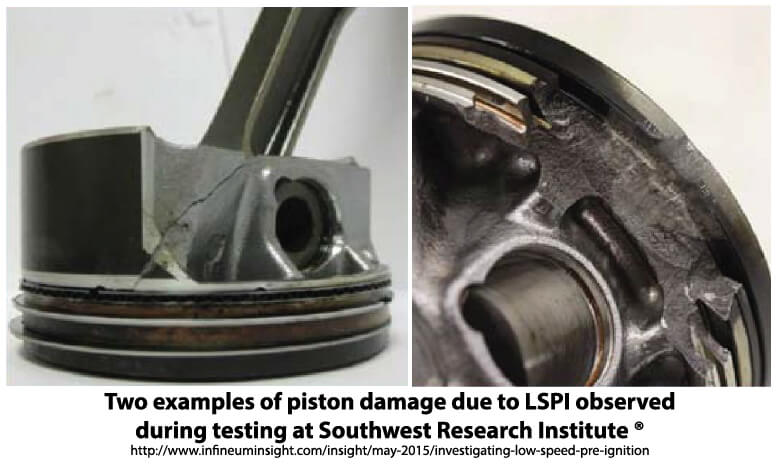LSPI engine damage
What is LSPI?
LSPI engine damage is caused by a pre-ignition event in the engine’s combustion chamber that causes heavy knock that breaks pistons and bends connecting rods.
 Today’s engines often use a turbocharger and gasoline direct injection (GDI) and multiple speed transmission to keep engine RPMS low and still obtain almost 25% more power from a smaller engine. Estimates show that by 2018 almost 65% of all new cars and trucks will have GDI. The turbocharger packs in more air molecules which allows for the addition of more fuel. GDI provides many advantages as well. Foremost among them is the ability to inject gasoline at extremely high pressures (up to 2,000-psi) which allows the atomized gas particles to cool the air/fuel mixture and prevent pre-detonation.
Today’s engines often use a turbocharger and gasoline direct injection (GDI) and multiple speed transmission to keep engine RPMS low and still obtain almost 25% more power from a smaller engine. Estimates show that by 2018 almost 65% of all new cars and trucks will have GDI. The turbocharger packs in more air molecules which allows for the addition of more fuel. GDI provides many advantages as well. Foremost among them is the ability to inject gasoline at extremely high pressures (up to 2,000-psi) which allows the atomized gas particles to cool the air/fuel mixture and prevent pre-detonation.
Unfortunately, GDI and turbocharging is producing some unintended consequences like low speed pre-ignition—a detonation of the air fuel mixture before spark trigger ignition. This pre-ignition combustion produces heavy engine knock which can damage internal engine components. The most common damage associated with this knock is broken piston rings, damaged pistons and bent connecting rods.
LSPI occurs at low-speed and high loads with high cylinder pressures. This low speed pre-igntion (LSPI) scenario occurs during low speed heavy acceleration before the spark , like punching the pedal to the metal during the 1-2 and 2-3 shift.
What causes LSPI engine damage?
When the air/fuel mixture is developed through turbocharging and GDI and ignited by the spark plug, gas flow dynamics produces some areas of incomplete combustion in the cylinder. This incomplete combustion produces carbon particulates. The particulate formation and emissions are actually higher in turbo/GDI engines than in traditional port-inject engines. Some of the particulates are pushed out during the exhaust stroke, but some of the particulates get trapped in crevices between the compression and oil piston rings and land areas. Particulates also attach to cylinder walls and get washed down into the crankcase during the next fuel injection cycle. That is causing problems with oil life monitoring systems since the car makers didn’t include those oil contamination scenarios into their oil life algorithm.
The surface of these carbon particles tend to absorb the most important anti-wear additives in the oil, compromising motor oil lubrication performance. If the particles break loose, they abrade critical engine parts such as camshafts and lifters. In some cases, these abrasive carbon particles can account for up to 3% of the total oil mass.
So engineers originally thought that the accumulation of these carbon soot particles caused hot spots to develop causing the pre-ignition. Extensive testing disproved that theory, showing that pre-ignition occurred randomly throughout the combustion chamber. If carbon deposit hot spots were the cause, the pre-ignition would occur in the same location. In addition to tracking the exact location of the pre-ignition, engineers also tested different oil additives to determine if changes in additives affected LSPI.
The researchers used calcium (Ca), phosphorous in the form of Zinc Di-Alkyl-Dithio-Phosphate (ZnDTP), molybdenum as Molybdenum Di-Thio Carbamate (MoDTC) and phenolic antioxidants (Phenolic-AO), all in varying amounts. The testing showed that LSPI increased by three times when calcium was increased from 0.1-0.2%. This appears to be the sweet spot because increasing calcium to 0.3% didn’t increase LSPI. Molybdenum and phosphorus showed better LSPI suppression, causing LSPI to disappear completely at concentrations of 0.07% and 0.15%. The testing also indicated that LSPI occurrences dropped as detergent additives were eliminated.
All this testing led experts to conclude that oil droplets are most likely cause of LSPI. The piston oil rings wipe a protective oil film onto the cylinder walls. Then, the introduction of high pressure fuel during the compression stroke dilutes that oil film. The oil dilution decreases the oil’s surface tension and its viscosity, causing a new “fuel” comprised of gasoline and lower viscosity motor oil. Tests show that this gas/oil combination accumulates between the upper most piston compression ring and the land area. As the piston rises during the compression stroke, the top compression ring pushes gas/oil droplets out of the land area. The high heat of compression and the heat caused by oxidation of these droplets causes them to vaporize and auto ignite. The result is heavy or “super-knocking” that damages engine components.
So it’s the combination of oil film wash down, oil viscosity and surface tension reduction, combination with gas, and extremely high combustion chamber pressures during the compression stroke that cause LSPI. This perfect storm scenario happens more often on smaller turbo charged vehicles with 6-speed transmissions because the engines operate and lower RPMs in most gear ranges. When driver’s demand acceleration at these low RPMs, they push the pedal to the metal, creating much higher combustion chamber pressures, causing LSPI.
How to stop LSPI engine damage?
Right now the focus is on finding an oil formulation with higher surface tension that won’t form droplets as easily.
Posted on by Rick Muscoplat
